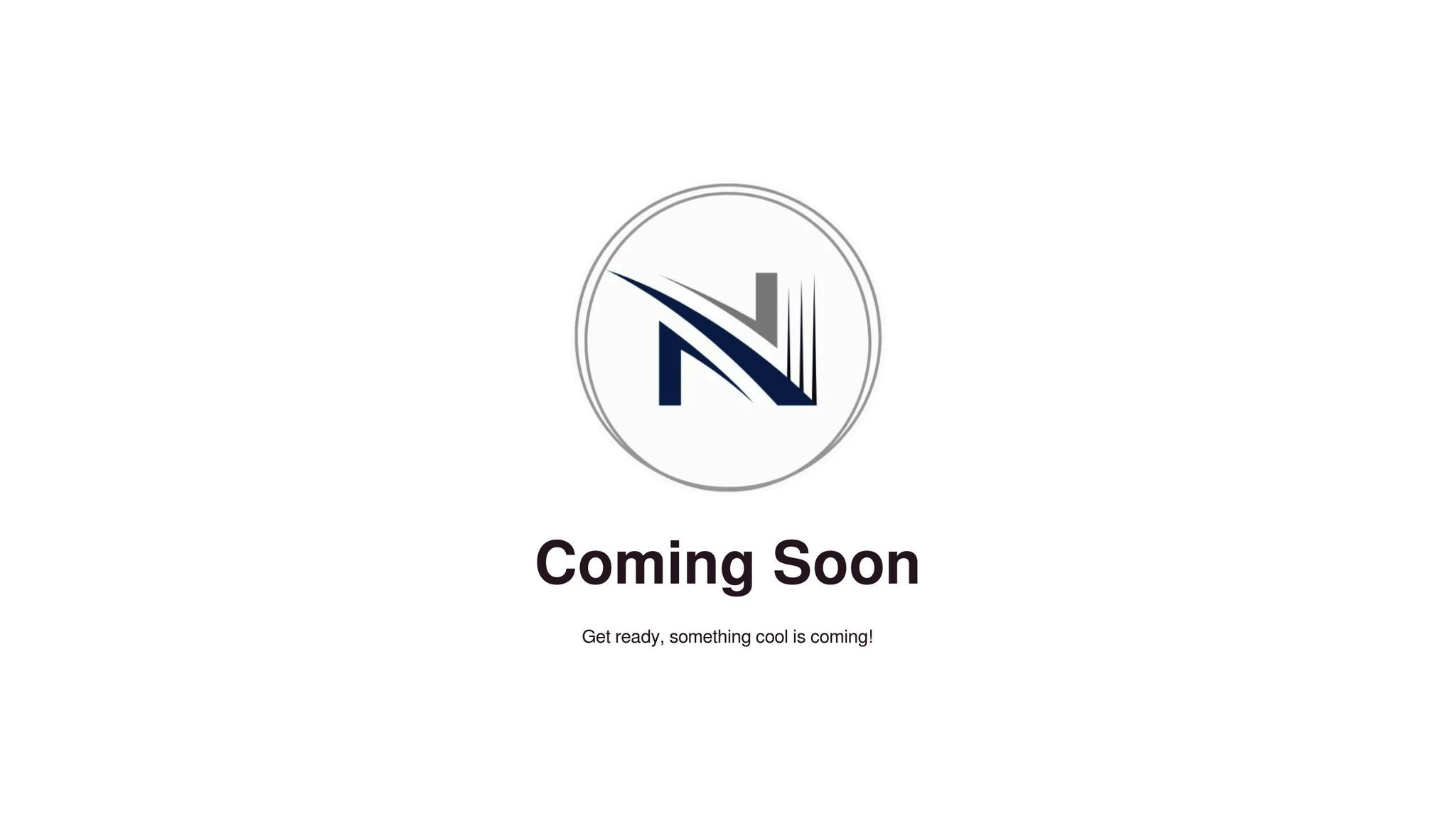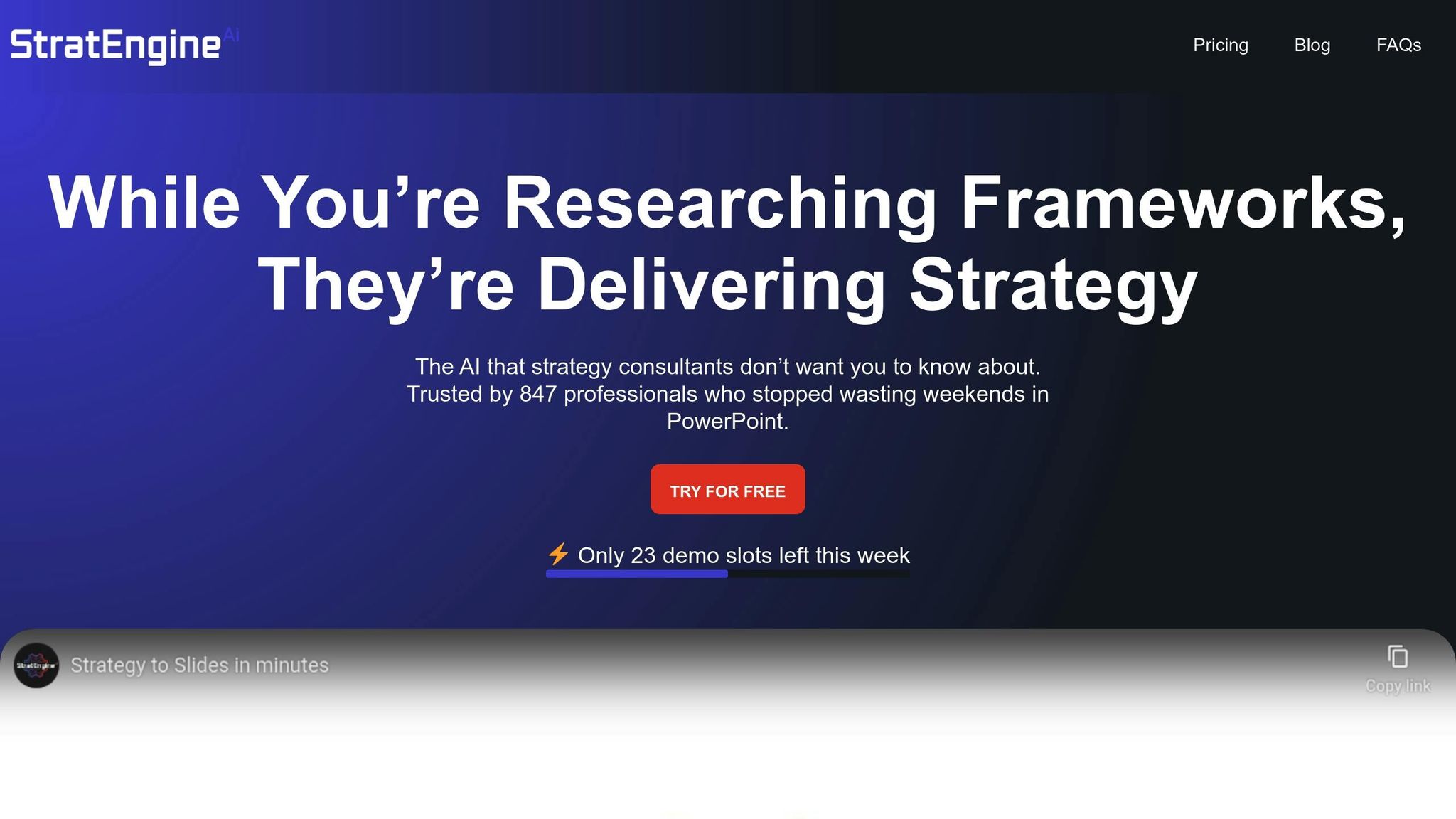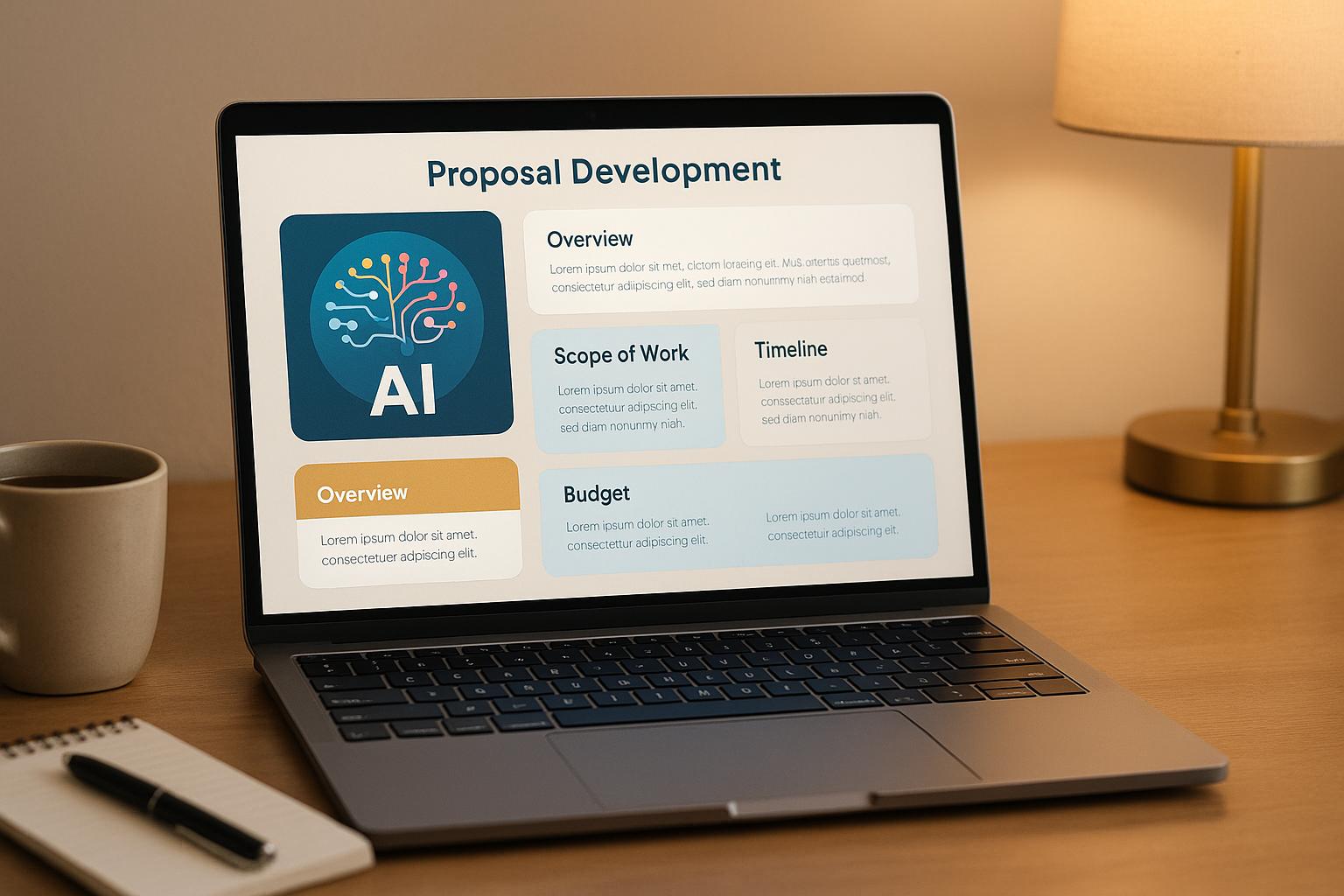AI is transforming how consulting firms allocate resources, tackling inefficiencies and improving decision-making. Traditional methods often lead to mismatched talent, missed deadlines, and budget overruns. AI frameworks solve these issues by analyzing data, predicting needs, and automating adjustments. Here's what you need to know:
- Time Savings: Consultants save an average of 18.5 hours per month.
- Increased Project Value: Firms see an average boost of $47,000 per project.
- Key Tools: AI solutions include StratEngineAI for strategic planning, predictive models for forecasting needs, and dynamic routing algorithms for real-time adjustments.
AI-driven tools help firms optimize workloads, reduce errors, and improve client satisfaction. Let’s explore how these systems work and why they’re reshaping consulting practices.
AI for Resource Management: How to Optimize Team Efficiency with Artificial Intelligence | NxtChair

Common Resource Allocation Challenges for Consultants
Consultants frequently face difficulties in aligning tasks, managing dependencies, and coordinating team members across intricate projects. To tackle these hurdles, some firms are turning to AI assistants. These tools help by gathering and fine-tuning data, making the resource allocation process smoother and more efficient. This highlights the growing importance of AI-based systems in simplifying resource management.
1. StratEngineAI

StratEngineAI is a game-changer for strategic planning, automating everything from research to presentation. Designed to tackle the challenge of balancing consultant time and expertise across multiple projects, this AI-powered platform ensures high-quality results while freeing up valuable hours for more impactful work. It’s a tool that helps consultants focus on what truly matters: delivering insights and making better decisions.
Automation That Frees Up Time and Resources
StratEngineAI’s automation engine takes over time-consuming tasks that used to drain consultants’ weekends. Instead of wrestling with slide decks and frameworks, consultants can now dedicate their energy to analysis and client interactions. The platform automatically generates strategic briefs packed with market insights, competitive intelligence, and actionable recommendations.
Priya M., a Strategy Manager at a Fortune 500 retailer, shared her experience:
"I used to spend a whole weekend building slides. Now I get the same quality output in an hour." [1]
This shift doesn’t just save time - it transforms how consultants work. By automating repetitive tasks, the platform allows professionals to focus on higher-value activities like strategic thinking and client engagement. And because the system is designed with flexibility in mind, it supports frameworks that can be applied across industries.
Tailored Solutions for Any Industry
StratEngineAI’s flexible framework system is built to adapt. With over 20 strategic frameworks - including SWOT analysis, Porter's Five Forces, and Blue Ocean Strategy - the platform offers consultants a toolkit for crafting customized strategies. Whether working with a tech startup or a manufacturing giant, there’s no need to reinvent the wheel for every new project.
The platform’s versatility means consultants can tackle a wide range of client challenges. Simply upload the specifics of a client’s needs, and StratEngineAI generates insights tailored to the industry and complexity of the problem. This adaptability cuts down on prep time while ensuring a high level of precision.
Driving Better Decisions and Greater Efficiency
By significantly reducing preparation time, StratEngineAI allows consultants to focus on delivering value. The numbers speak for themselves: users save an average of 18.5 hours per month and see an average project value increase of $47,000 [1].
Daniel K., an Independent Consultant, described how the platform has changed his workflow:
"What used to take me days of framework analysis and strategy development now takes hours. I can focus on insights instead of formatting." [1]
StratEngineAI doesn’t just save time - it raises the bar for quality. Consultants can deliver polished, in-depth strategies that impress even the toughest audiences. Sarah L., VP of Business Development at a SaaS startup, summed it up:
"Our board was impressed by the depth and polish of our strategic analysis. They said it looked like we hired a top-tier consulting firm." [1]
For smaller teams, this means enterprise-level results without scaling up time or staffing. StratEngineAI empowers consultants to deliver exceptional work efficiently, making it an indispensable tool in today’s fast-paced business environment.
2. Load Balancing Algorithms
Load balancing algorithms are designed to evenly distribute workloads across available resources. They take into account factors like project requirements, team skill sets, and resource capacity. What makes them stand out is their ability to make real-time adjustments, adapting as demands shift or grow. They also work seamlessly alongside other AI frameworks, ensuring a smooth and responsive system.
In the consulting world, where handling multiple projects and large volumes of data is the norm, these algorithms shine. They can process vast datasets and juggle numerous variables at once, maintaining both efficiency and precision - all without the need for constant manual oversight. This makes them invaluable for streamlining operations in data-heavy environments.
3. Predictive Allocation Models
Predictive allocation models use historical data and machine learning to forecast resource needs with precision. Instead of waiting to address issues as they arise, these models analyze past project patterns, factoring in details like timelines, client demands, seasonal fluctuations, and team performance metrics.
What’s impressive is how these systems evolve with each project. By continuously learning, they improve their predictions, fitting seamlessly into broader AI-driven resource management strategies.
Handling Large Datasets and Complex Scenarios
With the ability to process massive amounts of project data, predictive allocation models are particularly effective for consulting firms juggling hundreds of engagements. They track consultant workloads, skill requirements, and project schedules with remarkable accuracy.
As the datasets grow, the models become even sharper, picking up on patterns that might escape human planners. For firms managing diverse portfolios and intricate client needs, this scalability ensures resource predictions stay dependable, even as businesses expand and projects grow more complex.
Automating Resource Allocation
These models don’t just predict - they act. They automate tasks like forecasting resource shortages weeks in advance, suggesting the best team setups for future projects, and pinpointing when consultants will be free for new assignments.
AI tools embedded within these systems take over routine tasks, such as monitoring project progress and sending alerts when adjustments are needed. This automation allows senior consultants to dedicate more time to strategic planning and building client relationships.
Improving Decision-Making and Efficiency
Predictive allocation models provide consulting leaders with a clear, real-time view of resources, enabling proactive decisions instead of reactive fixes. This transparency ensures leaders can plan effectively for both current and future demands.
4. Dynamic Routing Algorithms
Dynamic routing algorithms take a real-time approach to managing resources, constantly adjusting consultant assignments as project conditions evolve. Unlike static methods, which rely on pre-set plans, these algorithms monitor factors like project progress, consultant availability, and client needs to make instant adjustments. By combining predictive models and load balancing, dynamic routing provides a flexible, responsive way to optimize resource distribution.
Here's how it works: these systems use decision trees to evaluate multiple factors at once. If a project faces delays, budget shifts, or scope changes, the algorithm recalculates the best resource allocation almost immediately. This means consultants can be reassigned in hours rather than waiting days for traditional planning cycles.
The real advantage lies in the ability to juggle competing priorities across multiple client engagements. For instance, if a project suddenly needs specialized expertise, the algorithm identifies consultants who can step in based on their skills, workload, and even their working relationships. This agility fills the gaps left by older allocation methods, aligning with the broader goal of using AI to streamline resource decisions.
Scalability for Large Datasets and Complex Environments
Dynamic routing algorithms shine when managing large-scale operations. Unlike static models, they continuously adapt as new data comes in, making them ideal for handling hundreds of projects simultaneously across various practice areas. They process vast datasets, including consultant schedules, project timelines, skill sets, and client preferences, all while maintaining quick response times.
To manage complexity, these algorithms use layered frameworks that prioritize high-stakes tasks but remain flexible enough for everyday operations. For example, critical client deliverables receive top priority, while routine tasks are handled efficiently in the background. As consulting firms grow, these systems scale effortlessly by incorporating new data sources and decision-making criteria. Whether managing 50 consultants or 5,000, the algorithms maintain a consistent quality of decisions, making them indispensable for large and diverse organizations.
Tailored to Industry and Client Needs
Different industries have unique requirements for resource allocation, and dynamic routing algorithms adapt easily to these variations. In technology consulting, for instance, the system might prioritize certifications and recent technical experience. In contrast, financial services projects might focus on regulatory expertise and security clearances.
Over time, these algorithms learn from industry-specific trends. For example, healthcare projects often involve lengthy regulatory approval phases, while retail engagements might demand quick turnarounds during busy seasons. This embedded intelligence allows the algorithms to fine-tune their decisions for different sectors, improving accuracy and efficiency.
Client preferences also play a role. Some clients want consistent teams for long-term projects, while others prefer new perspectives from rotating consultants. The algorithms account for these preferences, ensuring resource assignments align with both client expectations and relationship strategies.
Automating Routine Resource Allocation
Dynamic routing algorithms excel at automating time-consuming allocation tasks. For example, if a consultant finishes a project early or if a timeline extends unexpectedly, the system quickly identifies the next best assignment based on skills, availability, and strategic priorities. Integrated notification systems keep everyone updated on changes, while the automation extends to capacity planning. These algorithms can forecast resource needs weeks in advance, flagging potential conflicts before they disrupt client deliverables.
Boosting Decision-Making and Operational Efficiency
With dynamic routing, consulting leaders gain real-time visibility into resource use across the organization. Dashboards highlight underutilized consultants and overworked teams, enabling quick adjustments to maintain balance and efficiency.
The speed of decision-making improves significantly when routine allocation tasks are automated. This frees up senior consultants to focus on big-picture strategies and client relationships rather than administrative work. Tasks that once required lengthy coordination meetings now happen automatically, cutting down on overhead and streamlining operations.
These systems also enhance client satisfaction by ensuring the right expertise is deployed quickly. When a client needs additional resources or specialized skills, the algorithm can assign qualified consultants within the same day. This responsiveness not only meets immediate needs but also lays the groundwork for long-term improvements in consulting operations.
sbb-itb-7250072
5. Task Distribution Algorithms
Task distribution algorithms are designed to streamline how tasks are assigned in complex projects. By analyzing factors like requirements, team capabilities, and workloads, these systems ensure tasks are distributed in a way that improves efficiency and enhances project results. They consider critical variables, such as matching skills to tasks and assessing team members' availability, to keep everything running smoothly.
These algorithms also break down large projects into smaller, manageable tasks while maintaining the connections between them. This approach reduces delays caused by dependencies, where one person's work impacts another's schedule. It builds on earlier AI frameworks, focusing specifically on coordinating tasks at a granular level.
Handling Large Datasets and Complex Projects
One of the strengths of task distribution algorithms lies in their ability to scale. They process real-time data from project management systems to adapt task assignments as project conditions shift. This makes them especially useful for managing large portfolios and intricate environments.
Automating Resource Allocation
These algorithms take over many manual coordination tasks, saving time and reducing errors. They categorize project requests by complexity and urgency, assign tasks based on predefined rules, and flag potential delays or conflicts early. By automating routine updates and notifications, they allow project managers to focus on higher-level strategies instead of getting bogged down in day-to-day details.
Improving Decision-Making and Efficiency
With real-time insights into team workloads, these systems make capacity planning and skill development easier. They automate straightforward assignments while escalating more complex decisions to managers. This hybrid approach not only speeds up decision-making but also ensures deadlines are met and clients are satisfied with the results.
6. Reinforcement Learning Models for Resource Optimization
Reinforcement learning models work by refining resource allocation through a trial-and-error process. These models continuously adjust and improve as they learn from outcomes, making them well-suited for handling changes in project scopes or team availability. This dynamic approach lays the groundwork for more advanced AI-driven workforce planning techniques.
7. AI-Powered Workforce Planning Tools
AI-powered workforce planning tools are changing the way resources are managed by automating tasks and offering real-time insights. These platforms simplify data management, identify risks, and prioritize tasks, enabling consultants to allocate resources more effectively and concentrate on strategic goals. Let’s break this down into three key areas: handling large datasets, automation, and smarter decision-making.
Managing Large Datasets with Ease
Consulting firms deal with a wide variety of data, from consultant schedules to detailed project requirements. AI-driven workforce tools can process these complex data streams quickly, ensuring a clear and up-to-date view of resources. This is especially helpful when juggling multiple projects with competing priorities.
Automation to Simplify Resource Allocation
These tools take over repetitive tasks like data entry and risk identification, saving time and reducing errors. They can also automatically sort and assign resource requests to the right people, speeding up decision-making. Plus, with no-code workflow options, teams can create processes that are both consistent and adaptable.
Smarter Decisions Backed by AI
From planning project timelines to managing sprints and workflows, these tools provide leaders with detailed, data-backed insights. This empowers consultants to make better resource allocation decisions and focus on tasks that deliver the most value. By taking the guesswork out of planning, these systems help streamline operations and improve overall efficiency.
Best Practices for Using AI in Resource Allocation
To get the most out of AI in resource allocation, it’s essential to align its use with clear goals, reliable data, and a commitment to ongoing refinement. Below, we’ll break down the key steps to effectively integrate AI into your resource management strategy.
Start with Clear Objectives
Before diving into AI implementation, define what you want to achieve. Are you aiming to cut project delivery times, improve how consultants are utilized, or boost client satisfaction? By setting specific and measurable goals, you’ll not only identify the right AI tools but also have a way to assess their impact over time.
These objectives should tie directly to your broader business priorities and be achievable within a reasonable timeframe. A phased rollout often works best, giving your organization room to adapt and refine the process as needed.
Make Data Quality Your Top Priority
AI is only as good as the data it relies on. If your data isn’t accurate, your AI’s recommendations won’t be either. Start by reviewing your existing data sources - things like past project records, consultant skill profiles, client needs, and time-tracking logs.
To maintain consistency and accuracy, establish clear data standards. This could involve standardizing how information is gathered, stored, and updated across teams. Regular data cleaning - like removing duplicates or fixing errors - combined with automated validation rules to catch inconsistencies, ensures your AI tools are working with reliable information.
Select the Right Algorithms for Your Needs
Choosing the right algorithm is critical. For example, predictive models work well for estimating future resource needs, while optimization algorithms shine when you need to make real-time decisions. The key is to match the algorithm to the specific challenge you’re trying to solve.
When evaluating options, consider factors like how much data you have, the complexity of the decisions you’re addressing, and how quickly you need results. In cases where data is limited, simpler models might be more effective. For more complex, variable-heavy scenarios, advanced algorithms could be the better choice.
Track Performance Metrics Regularly
Consistently monitoring metrics is essential to gauge whether your AI system is delivering results. For instance, metrics like saving 18.5 hours per month or increasing project value by $47,000 [1] can provide tangible evidence of success. Regular tracking helps you identify areas for improvement and ensures your AI efforts stay on track.
Use Feedback Loops to Keep Improving
AI systems thrive on learning from new data and real-world outcomes. Set up regular review cycles to fine-tune your AI tools based on what’s working and what isn’t. Encourage consultants and project managers to share their feedback on AI recommendations. This “human-in-the-loop” approach ensures your AI remains relevant and aligned with the realities of your workplace.
Train Your Team to Maximize AI Benefits
Invest in training programs to help your team understand how AI works and how to use its insights effectively. Focus on showing practical examples and real-world benefits to build trust and confidence in the system. When your team sees how AI can simplify their work and enhance decision-making, they’ll be more likely to embrace it.
Conclusion
AI-powered resource allocation frameworks are reshaping consulting operations, shifting them from traditional, reactive approaches to proactive, data-driven strategies. The tools discussed - ranging from load balancing algorithms to reinforcement learning models - equip consultants with the ability to enhance project outcomes while improving team efficiency. This shift paves the way for smoother operations and more strategic decision-making.
Firms that adopt these AI-driven frameworks see measurable improvements in efficiency and client satisfaction. With the ability to accurately forecast resource needs, balance workloads, and respond to shifting project demands in real time, consultants can deliver higher-quality results. At the same time, they reduce burnout and foster a more motivated and productive team environment.
What sets these frameworks apart is their ability to tackle the complex decisions inherent in consulting work. Unlike traditional resource planning methods, which often rely on intuition or outdated data, AI frameworks analyze scenarios and make optimal allocation decisions in a fraction of the time.
However, success hinges on careful implementation. Clear objectives, high-quality data, and selecting algorithms tailored to specific challenges are critical steps in realizing the full potential of these tools.
By leveraging solutions like StratEngineAI, consulting firms can revolutionize resource allocation from initial analysis to final presentation. As explored earlier, each framework - whether focused on predictive modeling or workload balancing - contributes to a cohesive strategy that elevates consulting practices. The same automated analysis and proven methodologies that drive success in strategic planning can be directly applied to resource management challenges.
Consultants who integrate AI frameworks into their processes achieve better results while building sustainable and efficient practices. These frameworks align seamlessly with advanced strategic planning techniques, offering a clear path to optimizing resource allocation. The tools are ready, the methods are tested, and the opportunity is waiting for those prepared to embrace this game-changing transformation.
FAQs
How does StratEngineAI help consultants work more efficiently and deliver greater value to their clients?
StratEngineAI makes strategic planning faster and more efficient by automating tasks that usually take hours - like creating detailed strategic frameworks and presentation slides. With this tool, what once required days can now be done in just minutes.
Using advanced AI, the platform delivers in-depth market analyses, competitive insights, and actionable recommendations, all customized to meet the needs of consultants and their clients. This frees up consultants to concentrate on developing powerful strategies rather than getting bogged down in manual prep work, boosting both project outcomes and client satisfaction.
What challenges in resource allocation can AI frameworks help consulting firms solve?
AI frameworks tackle key challenges in resource allocation that consulting firms often face. They help boost workflow efficiency, strengthen team collaboration, and support data-driven decision-making. By automating routine tasks and processing complex data, AI enables consultants to allocate resources more effectively, allowing them to concentrate on high-impact strategic priorities.
These tools also offer real-time insights, helping firms quickly spot bottlenecks, improve team utilization, and anticipate project requirements. This speeds up decision-making and ensures that resources are aligned with client objectives, leading to more successful outcomes.
How do dynamic routing algorithms optimize resource allocation in consulting projects?
Dynamic routing algorithms bring a smarter approach to managing resources in consulting projects by enabling real-time adjustments as project needs shift. Unlike older, static planning methods, these algorithms actively evaluate factors like changing workloads, resource availability, and unforeseen delays to make informed, data-backed decisions about resource allocation.
This flexible approach helps distribute resources more effectively, cutting down on downtime and avoiding bottlenecks. The result? Smoother project execution, improved performance, and the ability for consulting teams to quickly adapt to changes - all while keeping clients satisfied with timely and efficient results.


